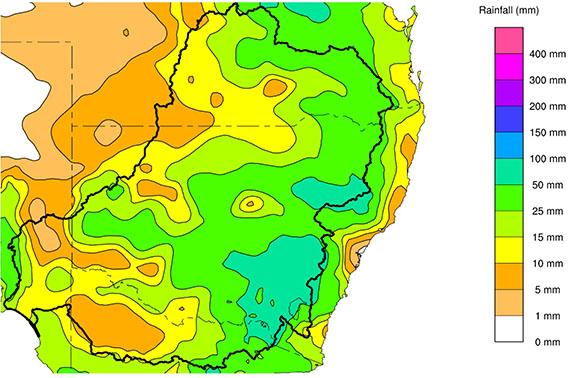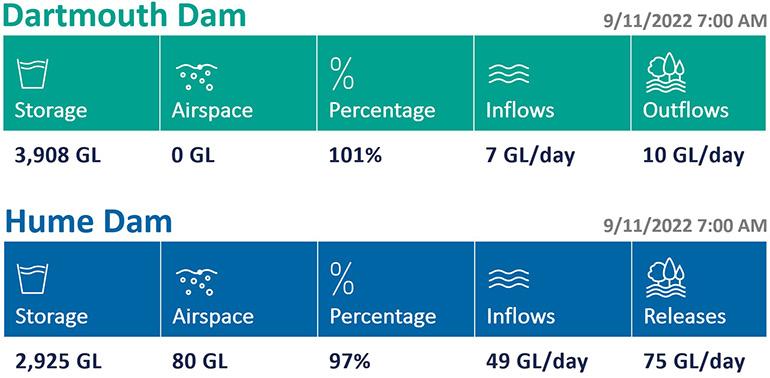The regular update includes:
- catchment conditions
- forecast rainfall and inflows
- water releases
- planned management for the coming week.
Catchment conditions
For the week of 1 to 7 November the rainfall across the Murray–Darling Basin was largely above average with most areas receiving 25 – 50mm. Soil moisture levels for the Upper Murray have eased slightly since last week to 74%, which continues to be in the top 1% of historical values for this time of year.

Forecast rainfall and inflows

The Bureau of Meteorology is expecting rainfall totals to 14 November 2022 to be in the range of 50 – 100mm across parts of the Upper Murray catchment. Models currently show that this rainfall could cross the area late in the weekend on Sunday and possibly on Monday.
The 7-day forecast map is automatically generated and subject to change daily when the models are run.
The outlook for the next 3 months shows a high chance of above-median rainfall.
The Bureau of Meteorology is the best source of information to stay up-to-date with forecast rainfall and flood information.
The status of the Bureau of Meteorology’s El Niño–Southern Oscillation Outlook is currently La Niña. The Bureau suggests this La Niña event may return to neutral conditions early in 2023. La Niña events increase the chances of above-average rainfall during spring and summer for northern and eastern Australia.
In addition, the negative Indian Ocean Dipole (IOD) event is likely to continue through late spring. A negative IOD event is typically associated with above average spring rainfall for much of Australia.
Snapshot: Dartmouth and Hume

The Bureau of Meteorology is the best source of information to stay up-to-date with forecast rainfall and flood information.
The status of the Bureau of Meteorology’s El Niño–Southern Oscillation Outlook is currently La Niña. The Bureau suggests this La Niña event may return to neutral conditions early in 2023. La Niña events increase the chances of above-average rainfall during spring and summer for northern and eastern Australia.
In addition, the negative Indian Ocean Dipole (IOD) event is likely to continue through late spring. A negative IOD event is typically associated with above average spring rainfall for much of Australia.

Dartmouth Dam and Hume Dam this week
Flood operations are being conducted at both dams.
Rainfall models indicate the likelihood of a significant rainfall event beginning Sunday or Monday over the Basin catchments.
The MDBA is working closely with the Bureau of Meteorology to understand this event and the likely inflows to the dams and rivers that it may generate. We are currently creating airspace at Hume Dam ahead of this next weather event, however if forecasts indicate additional airspace is required then releases from the dam will be increased, possibly as soon as today. The Bureau provides information on river heights in specific locations. Please refer to them for further details, as releases from Hume Dam into the Murray River may not reflect what is happening in your immediate area.
Flows are continuing over the spillway at Dartmouth Dam. The flow in the Mitta Mitta River will be dependent on the volume flowing over the spillway plus inflows from tributaries downstream of the dam. The Mitta Mitta River at Tallandoon receded below the minor flood level on Monday evening.
The situation is constantly evolving, and rivers can rise very quickly.
The MDBA does not provide flow forecasts during periods of flooding. For this information, please refer to the Bureau of Meteorology.
Are you flood ready?
If you live, work or holiday on a floodplain, be prepared

Develop your personalised flood emergency plan for your home and property
www.ses.nsw.gov.au
www.ses.vic.gov.au/plan-and-stay-safe

All residents can sign up for the Early Warning Network to be notified about Hume Dam release activities during periods of flooding or high releases
www.waternsw.com.au/supply/ewn

Check the BoM website to receive the latest weather and flood information and warnings in your area
www.bom.gov.au/australia/flood
www.bom.gov.au/australia/warnings